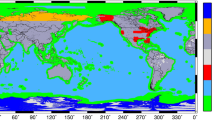Abstract
A simple effective method of inverse estimation provided by model Green’s functions is examined to calibrate tides in a regional circulation model for the East Asian marginal seas. The Green’s function optimization derived by perturbing the model parameters significantly improves the estimate relative to observation as compared with baseline integration. Among the optimized model parameters, the largest effects on cost function reduction come first from the harmonic constant of M2 along the open boundaries with the optimized values of 89.7 ± 0.8% for amplitude, and second from the bottom friction with the optimized value of (3.06 ± 0.08) × 10−3.





Similar content being viewed by others
References
Amante C, Eakins BW (2009) ETOPO1 1 arc-minute global relief model: procedures, data sources and analysis, National Geophysical Data Center, NOAA, Technical Memorandum NESDID NGDC-24
Book JW, Pistek P, Perkins H, Thompson KR, Teague WJ, Jacobs GA, Suk M-S, Chang K-I, Lee J-C, Choi BH (2004) Data assimilation modeling of the barotropic tides in the Korea/Tsushima Strait. J Oceanogr 60:977–993
Choi BH, Ko JS (1994) Modeling of tides in the East Asian Marginal Seas. J Korean Soc Coast Ocean Eng 6(1):94–108
Choi BH, Kim KO, Eum HM (2002) Digital bathymetric and topographic data for neighboring seas of Korea. J Korean Soc Coastal Ocean Eng 14:41–50 (in Korean with English abstract)
Choi BH, Eum HM, Woo SB (2003) Modeling of coupled tide-wave-surge process in the Yellow Sea. Ocean Eng 30:739–759
General Bathymetric Chart of the Ocean (GEBCO) (2009) Last retrieved: October 18, 2009. Available from: http://www.gebco.net/
Guo X, Yanagi T (1998) Three-dimensional structure of tidal current in the East China Sea and the Yellow Sea. J Oceanogr 54:651–668
Hirose N (2005) Least-squares estimation of bottom topography using horizontal velocity measurements in the Tsushima/Korea Straits. J Oceanogr 61:789–794
Hirose N (2011) Inverse estimation of empirical parameters used in a regional ocean circulation model. J Oceanogr. doi:10.1007/s10872-011-0041-4
Kang SK, Chung J-Y, Lee S-R, Yum K-D (1995) Seasonal variability of the M2 tide in the seas adjacent to Korea. Cont Shelf Res 15:1087–1113
Kang SK, Foreman MGG, Lie H-J, Lee J-H, Cherniawsky J, Yum K-D (2002) Two-layer tidal modeling of the Yellow and East China Seas with application to seasonal variability of the M2 tide. J Geophys Res 107(C3). 10.1029/2001JC000838
Kantha LH (1995) Barotropic tides in the global oceans from a nonlinear tidal model assimilating altimetric tides 1. Model description and results. J Geophys Res 100(C12):25283–25308
Le Provost C, Molines JM, Lyard F, Genco ML, Rabilloud F (1995) A global ocean tide prediction model based on the hydrodynamic finite element solutions FES94.1 improved by assimilation of the CSR2.0 T/P solutions (abstract). Paper presented at symposium operational oceanography and satellite observation, Biarrits
Lee HJ, Yoon JH, Kawamura H, Kang H-W (2003) Comparison of RIAMOM and MOM in modeling the East Sea/Japan Sea circulation. Ocean Polar Res 25:287–302
Lefèvre F, Le Provost C, Lyard FH (2000) How can we improve a global ocean tide model at a regional scale? A test on the Yellow Sea and the East China Sea. J Geophys Res 105(C4):8707–8725
Liu CS, Liu SY, Lallemand SE, Lundberg N, Reed D (1998) Digital elevation model offshore Taiwan and its tectonic implications. Terr Atmos Ocean Sci 9:705–738
Lu X, Zhang J (2006) Numerical study on spatially varying bottom friction coefficient of a 2D tidal model with adjoint method. Cont Shelf Res 26:1905–1923
Marine Information Research Center (2003) JTOPO1—Northwestern Pacific bathymetric data with 1-minute grid. Japan Hydrographic Association. CDROM (in Japanese)
Matsumoto K, Ooe M, Sato T, Segawa J (1995) Ocean tide model obtained from TOPEX/POSEIDON altimetry data. J Geophys Res 100(C12):25319–25330
Matsumoto K, Takanezawa T, Ooe M (2000) Ocean tide models developed by assimilating TOPEX/POSEIDON altimeter data into hydrodynamical model: a global model and a regional model around Japan. J Oceanogr 56:567–581
Menemenlis D, Wunsch C (1997) Linearization of an oceanic circulation model for data assimilation and climate studies. J Atmos Ocean Technol 14:1420–1443
Menemenlis D, Fukumori D, Lee T (2005) Using Green’s functions to calibrate an ocean general circulation model. Mon Weather Rev 133:1224 –1240
Moon IJ (2005) Impact of a coupled ocean wave-tide-circulation system on coastal modeling. Ocean Model 8(3):203–236
Morimoto A (2009) Evaluation of tidal error in altimetry data in the Asian marginal seas. J Oceanogr 65:477–485
National Geophysical Data Center (1988) ETOPO-5 Bathymetry/Topography Data, Data Announc. 88-MGG-02. National Oceanic and Atmospheric Administration, U.S. Department of Commerce, Boulder
National Geophysical Data Center (2001) ETOPO-2 Global 2′ elevations. National Oceanic and Atmospheric Administration, U.S. Department of Commerce, Boulder
Ray RD, Eanes RJ, Chao BF (1996) Detection of tidal dissipation in the solid Earth by satellite tracking and altimetry. Nature 381:595–597
Sandy RJ (1996) The Navy’s bathymetric databases—from the Sea. Sea Technol 37:53–56
Stammer D et al (2003) Volume, heat, and freshwater transports of the global ocean circulation 1993–2000, estimated from a general circulation model constrained by World Ocean Circulation Experiment (WOCE) data. J Geophys Res 108:3007. doi:10.1029/2001JC001115
Teague WJ, Pistek P, Jacobs GA, Perkins HT (2000) Evaluation of tides from TOPEX/Poseidon in the Bohai and Yellow Seas. J Phys Oceanogr 17:679–687
Wunsch C (1996) The ocean circulation inverse problem. Cambridge University Press, Cambridge
Acknowledgments
The authors express their sincere thanks to the journal editor and two anonymous reviewers for useful suggestions on improving the manuscript.
Author information
Authors and Affiliations
Corresponding author
Rights and permissions
About this article
Cite this article
Moon, JH., Hirose, N. & Morimoto, A. Green’s function approach for calibrating tides in a circulation model for the East Asian marginal seas. J Oceanogr 68, 345–354 (2012). https://doi.org/10.1007/s10872-011-0097-1
Received:
Revised:
Accepted:
Published:
Issue Date:
DOI: https://doi.org/10.1007/s10872-011-0097-1




